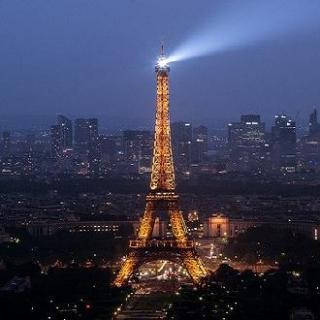
介绍:
想成为我们的主播,欢迎加微信 xdfbook 投稿。
一段美文,一首英文歌,或是一点生活感想,全由你做主。
《巴黎变形记》
The Man Who Created Paris
Paris remains one of the world’s most visited cities, and of those tens of millions drawn to its remarkably compact centre each year, the Marais district1) exerts a magnetic pull. Fashionable among aristocrats before Louis XIV—the “Sun King”—moved his court from Versailles, this pungent2) quarter of narrow streets and jumble of historic houses and courtyards sank into near-squalor3) in succeeding centuries before its renaissance in recent decades as a charming labyrinth of fashion boutiques, cafés, restaurants, museums and galleries.
Walking through these lively and endearing medieval streets, it seems almost incredible that they were once considered the enemy, to be demolished in haste—and not, it has to be added, by the German military, who had less than healthy4) designs on Paris at various times between 1870 and 1945. No, it was none other than the Emperor of France, Napoleon III, and his Prefect5) for the Seine, George-Eugène Haussmann6)—who died 125 years ago—who had districts like the Marais in their sights.
Like much of Paris, however, the Marais stank to high heaven7) in 1853 when the emperor instructed Haussmann to rebuild the odorous city along grand and salubrious8) lines. Entire medieval quarters of the city were to be razed9) with modern avenues taking their place. “It was the gutting of Paris,” wrote Haussmann proudly in his Memoires.
Demolition Man
A public administrator with no training in architecture or urban planning, Haussmann turned Paris into a titanic building site for 20 years. Even though he was forced to resign in 1870 as the emperor faced growing criticism for excessive expenditure, work on Haussmann’s plan continued until the late 1920s.
Conceived and executed in three phases, the plan involved the demolition of 19,730 historic buildings and the construction of 34,000 new ones. Old streets gave way to long, wide avenues characterised by rows of regularly aligned and generously proportioned neo-classical apartment blocks faced in creamy stone.
Along with imperious avenues, Haussmann engineered grand squares, city parks modelled on London’s Hyde Park10), a comprehensive sewage system, a new aqueduct giving wide access to fresh water, a network of underground gas pipes for lighting streets and buildings, elaborate fountains, grandiloquent11) public lavatories and rows of newly planted trees.
This urban infrastructure was matched by bold new railway stations—Gare du Nord12) and Gare de L’Est13)—the opulent14) Paris Opéra, new schools, churches, two dozen city squares, a brace15) of ambitious theatres at Place du Châtelet16), the giant, iron-framed Les Halles17) food market, and the sensational network of a dozen avenues radiating from the Arc de Triomphe18) at the core of Place de l’Ètoile19).
Since renamed Place Charles de Gaulle, l’Ètoile is every foreign driver’s nightmare experience: Well, you try heading into fast and furious traffic coming at you from 12 directions simultaneously while attempting to negotiate, or fight, your way around Napoleon Bonaparte’s monumental victory arch.
Rip It Up and Start Again
No other major city, before or since, has been transformed so radically during peacetime. It employed huge numbers of skilled and unskilled workers along with architects, engineers and landscape gardeners. It restored the city to health after long decades of cholera20) and typhus21). It gave Parisians of all classes parks to play and relax in.
Theoretically, its broad avenues allowed government troops free movement to maintain public order at times of barricades, riots and other disturbances. And, at a time when the city doubled in size and its population trebled, it gave Paris a sense of unity together with an air of bourgeois prosperity.
What still seems astonishing is that so much of the city was demolished and reordered on what seems like the whim22) of an emperor and his Prefect of the Seine, Haussmann. Napoleon III, however, was following in the footsteps of his uncle, Napoleon Bonaparte, who had equally grand designs on Paris. “If only the heavens had given me twenty more years of rule and a little leisure”, he wrote in exile on Saint Helena after the Battle of Waterloo, “one would search vainly for the old Paris; nothing of it would remain but vestiges.”
We’ll Always Have Paris
When in 1944, as Allied forces marched to liberate the city and Adolf Hitler gave orders for the wholesale demolition of Paris, the German military governor Major General Dietrich von Choltitz refused to obey. Paris was simply too beautiful to violate. Napoleon Bonaparte, Napoleon III and Baron Haussmann had not shared such precious German sentimentality.
Although bombastic, Haussmann’s monumental plan remains impressive, not least because he achieved so much so quickly to such a high, uniform standard. A public administrator by training, Haussmann was a commanding figure who, although a talented musician, was no sentimentalist. He even demolished the house he was born in—55 rue de Faubourg-du-Roule—despite fond memories of childhood.
Of his first meeting with Haussmann in 1853, Napoleon III noted, “I had in front of me one of the most extraordinary men of our time; big, strong, vigorous, energetic, and at the same time clever and devious, with a spirit full of resources.” The partnership between the ambitious French emperor and his vigorous prefect was a truly remarkable one. Within a year of Haussmann’s dismissal for overspending, however, Napoleon III had fallen after France’s defeat in the Franco-Prussian War. Released from a newly unified Germany, he went into exile at Chiselhurst, Kent where he died in 1873.
After his dismissal, Haussmann was elected Bonapartist deputy for Ajaccio, Corsica, birthplace of Napoleon Bonaparte. He found time to write three volumes of self-serving memoirs. These might be largely unread today, yet his memory lives on powerfully today in the new Paris he shaped—and in cities like Barcelona that followed his lead—if not in the narrow, but much-loved streets of the Marais.
迄今为止,巴黎依然是世界上游客最多的城市之一,玛莱区尤其具有磁铁般的吸引力,每年都吸引着数以千万计的游客涌向它异常拥挤的中心。在“太阳王”路易十四将王宫迁离凡尔赛宫之前,这一地带在贵族中一直是时尚的象征,但在之后几百年时间里,刺鼻的气味、狭窄的街道、凌乱的历史建筑和庭院使这一地区陷入了几乎肮脏不堪的境地,直到最近几十年,它才重新焕发了活力,精品时装店、咖啡馆、饭店、博物馆、美术馆纵横交错,犹如迷宫一般,散发着魅力。
漫步在这些充满活力、可爱迷人的中世纪街道,令人觉得不可思议的是,它们竟然曾被视若仇敌,需要被立即摧毁——而且,需要说明的是,摧毁它们的并不是德军,德军只是在1870到1945年间对巴黎有过一些不那么合理的设想。没错,摧毁它们的正是法兰西皇帝拿破仑三世和当时的塞纳省省长乔治-欧仁·奥斯曼(后者已于125年前去世),正是他们瞄准了玛莱区等区域。
然而,1853年的玛莱区和巴黎大多数地区一样,臭气熏天,因此,皇帝命令奥斯曼按照宏大、健康的原则重建这个臭哄哄的城市。巴黎的整个中世纪街区被夷为平地,取而代之的是现代化的林荫大道。“这就好比把巴黎的整个内脏都挖了出来。”奥斯曼在他的《回忆录》中自豪地写道。
拆房达人
作为公共行政长官,奥斯曼在建筑或城市规划方面没有受过任何训练,但他却将巴黎变成了一个超级庞大的建筑工地,时间长达20年。由于耗资庞大,皇帝受到越来越多的批评,奥斯曼被迫于1870年辞去职务。尽管如此,奥斯曼的改造计划依然如故,一直持续到20世纪20年代末。
该计划的构想和实施分为三个阶段,涉及19,730幢历史建筑的拆除和34,000幢新建筑的建造。古老的街道被宽阔的、长长的林荫大道所取代,两边是一排排新古典风格的公寓大楼,墙面镶嵌着乳白色的石头,整齐划一,雄伟高大。
除了足以傲视天下的宽阔街道,奥斯曼还建造了宏伟的广场、以伦敦海德公园为范本的城市公园、一个综合排水系统、一条可以为更多人提供淡水的新的引水渠、一个能为街道和建筑提供照明的地下煤气管道网络、精美的喷泉、奢华到没朋友的公共厕所以及一排排新栽的树木。
与这些城市基础设施相配套的有引人瞩目的新火车站(巴黎北站和巴黎东站)、奢华的巴黎歌剧院、新的学校、教堂、20多个城市广场以及夏特勒广场上那两座宏伟的剧院,还有巨大的、钢铁骨架构造的中央菜市场,以及一套令人瞠目的由十几条林荫大道组成的交通网络。这些林荫大道以位于星形广场中央的凯旋门为核心,向四面八方辐射。
自被重新命名为戴高乐广场以来,星形广场就一直是每个外国司机的噩梦:试想,面对12个方向同时涌来的飞速行驶的车流,你该怎样使出浑身解数,才能绕过拿破仑·波拿巴那不朽的凯旋门杀出一条路来?
破旧立新
在和平时期对一座大城市进行如此翻天覆地的改造,这恐怕是前无古人、后无来者的。除建筑师、工程师和园林美化师之外,巴黎的改造工程还雇用了无数的技术和非技术工人。在经历了长达几十年之久的霍乱和斑疹伤寒肆虐期之后,巴黎又恢复到了健康的状态。各个阶层的巴黎人都有了可供休闲与放松的公园。
从理论上说,宽阔的街道可以使政府军队在发生暴乱或其他骚乱以及道路被示威者阻断的情况下自由调动。另外,在城市规模扩大一倍、人口数量增加两倍的时期,这次改造给了巴黎一种团结一致的感觉,以及资本主义欣欣向荣的繁荣感。
如今仍令人感到震惊的是,如此大规模的城市拆除与重建似乎仅仅是因为一位皇帝和当时的塞纳省省长奥斯曼的心血来潮、一时兴起。不过,拿破仑三世实际上是在遵循其叔叔拿破仑·波拿巴的脚步,后者也曾有过同样大手笔的巴黎改造计划。滑铁卢战役之后,拿破仑·波拿巴在圣赫勒拿岛流亡时曾这样写道:“如果上天能够再多让我统治20年,再多给我一点闲暇时间,那么人们就再也见不到过去的巴黎了。除了一些遗迹,老巴黎将荡然无存。”
巴黎永恒
1944年,当盟军进军巴黎,准备解放这座城市时,阿道夫·希特勒下令将巴黎全部摧毁,但德军驻巴黎战区的司令官迪特里希•冯•肖尔蒂茨少将却拒绝执行这一命令。巴黎实在是太美了,美得让人不忍侵犯。但拿破仑·波拿巴、拿破仑三世和奥斯曼男爵却都没有德国人的这种可贵情怀。
…………
文章摘自:《新东方英语》杂志2016年11月号
大家还在听

